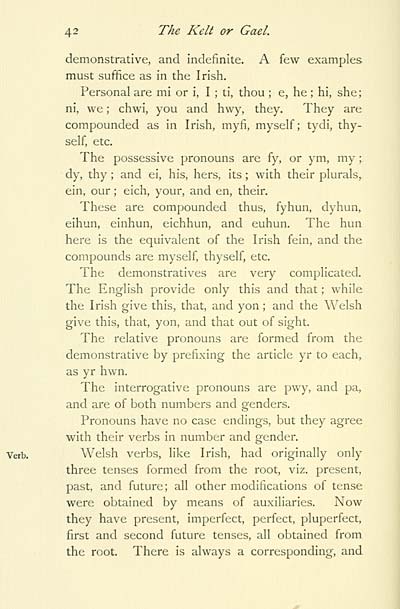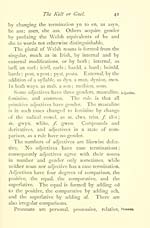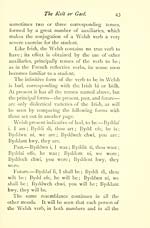Blair Collection > Kelt or Gael
(46)
Download files
Complete book:
Individual page:
Thumbnail gallery: Grid view | List view

42 The Kelt or Gael.
demonstrative, and indefinite. A few examples
must suffice as in the Irish.
Personal are mi or i, I ; ti, thou ; e, he ; hi, she;
ni, we ; chwi, you and hwy, they. They are
compounded as in Irish, myfi, myself; tydi, thy-
self, etc.
The possessive pronouns are fy, or ym, my ;
dy, thy ; and ei, his, hers, its ; with their plurals,
ein, our ; eich, your, and en, their.
These are compounded thus, fyhun, dyhun,
eihun, einhun, eichhun, and euhun. The hun
here is the equivalent of the Irish fein, and the
compounds are myself, thyself, etc.
The demonstratives are very complicated.
The English provide only this and that ; while
the Irish give this, that, and yon ; and the Welsh
give this, that, yon, and that out of sight.
The relative pronouns are formed from the
demonstrative by prefixing the article yr to each,
as yr hwn.
The interrogative pronouns are pwy, and pa,
and are of both numbers and genders.
Pronouns have no case endings, but they agree
with their verbs in number and gender.
Welsh verbs, like Irish, had originally only
three tenses formed from the root, viz. present,
past, and future; all other modifications of tense
were obtained by means of auxiliaries. Now
they have present, imperfect, perfect, pluperfect,
first and second future tenses, all obtained from
the root. There is always a corresponding, and
demonstrative, and indefinite. A few examples
must suffice as in the Irish.
Personal are mi or i, I ; ti, thou ; e, he ; hi, she;
ni, we ; chwi, you and hwy, they. They are
compounded as in Irish, myfi, myself; tydi, thy-
self, etc.
The possessive pronouns are fy, or ym, my ;
dy, thy ; and ei, his, hers, its ; with their plurals,
ein, our ; eich, your, and en, their.
These are compounded thus, fyhun, dyhun,
eihun, einhun, eichhun, and euhun. The hun
here is the equivalent of the Irish fein, and the
compounds are myself, thyself, etc.
The demonstratives are very complicated.
The English provide only this and that ; while
the Irish give this, that, and yon ; and the Welsh
give this, that, yon, and that out of sight.
The relative pronouns are formed from the
demonstrative by prefixing the article yr to each,
as yr hwn.
The interrogative pronouns are pwy, and pa,
and are of both numbers and genders.
Pronouns have no case endings, but they agree
with their verbs in number and gender.
Welsh verbs, like Irish, had originally only
three tenses formed from the root, viz. present,
past, and future; all other modifications of tense
were obtained by means of auxiliaries. Now
they have present, imperfect, perfect, pluperfect,
first and second future tenses, all obtained from
the root. There is always a corresponding, and
Set display mode to: Large image | Transcription
Images and transcriptions on this page, including medium image downloads, may be used under the Creative Commons Attribution 4.0 International Licence unless otherwise stated. ![]()
| Early Gaelic Book Collections > Blair Collection > Kelt or Gael > (46) |
|---|
| Permanent URL | https://digital.nls.uk/75787190 |
|---|
| Description | His ethnography, geography and philology. |
|---|---|
| Shelfmark | Blair.17 |
| Additional NLS resources: | |
| Attribution and copyright: |
|
| Description | A selection of books from a collection of more than 500 titles, mostly on religious and literary topics. Also includes some material dealing with other Celtic languages and societies. Collection created towards the end of the 19th century by Lady Evelyn Stewart Murray. |
|---|
| Description | Selected items from five 'Special and Named Printed Collections'. Includes books in Gaelic and other Celtic languages, works about the Gaels, their languages, literature, culture and history. |
|---|

